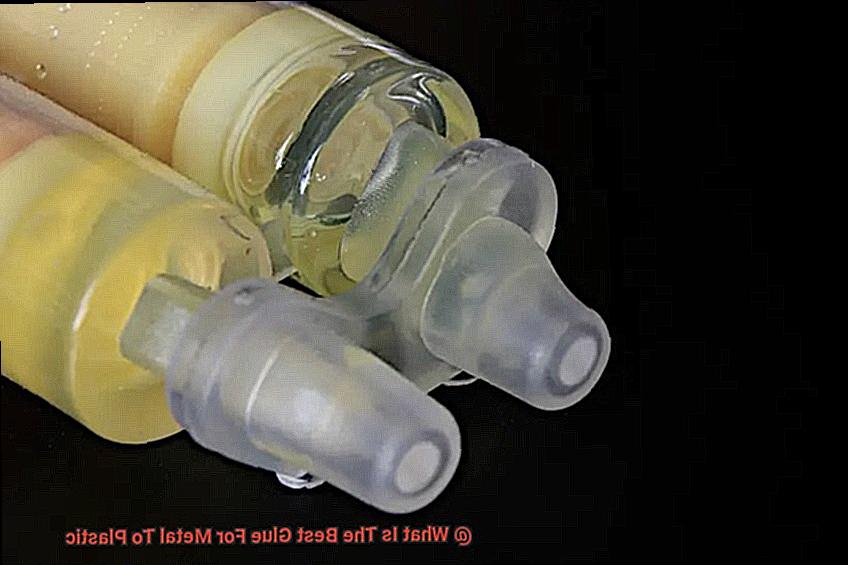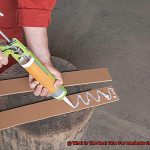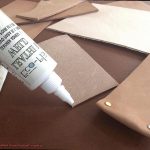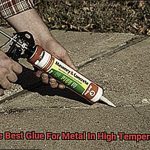Looking to bond metal to plastic?
It’s no easy feat, but fear not. I’ve got the inside scoop on the best glue for this tricky task.
We all know that a strong bond is key, so we’ll be diving into adhesives that can handle the job with ease. From compatibility to ease of use and overall strength, we’ll cover all the bases.
So let’s get started and find the glue that will bring your metal and plastic together like they were meant to be.
Different Types of Glue for Metal to Plastic Bonding
Contents
- 1 Different Types of Glue for Metal to Plastic Bonding
- 2 Considerations When Choosing the Best Glue for Metal to Plastic
- 3 Epoxy Adhesives for Metal to Plastic Bonding
- 4 Cyanoacrylate Adhesives for Metal to Plastic Bonding
- 5 Specialized Adhesives for Specific Applications
- 6 Environmental Factors and Their Impact on Glue Performance
- 7 Strength and Flexibility Requirements in Metal to Plastic Bonding
- 8 Conclusion
Glue is the magical force that allows metal and plastic to stick together, offering a world of possibilities for bonding various materials. In this marvelous world of adhesive, there are several types of glue available for bonding metal to plastic, each with its own distinct advantages and disadvantages. Let’s explore these options and discover the perfect glue for your specific needs.
Epoxy Adhesive: The Superhero of Bonding
Epoxy adhesive is the superhero of bonding, renowned for its exceptional strength and durability. It can bond different types of metals, including steel, aluminum, and even PVC, to plastics. By mixing the resin and hardener together, applying the mixture to the surfaces, and allowing it to cure, epoxy forms a robust and long-lasting bond. However, it is important to note that epoxy requires a curing time to achieve its full strength.
Cyanoacrylate Glue: The Quick Fixer
For those seeking a quick fix, cyanoacrylate glue, commonly known as super glue, is the perfect sidekick. This fast-drying adhesive creates an instant bond between metal and plastic surfaces. It excels on smooth surfaces and provides a strong hold. However, caution must be exercised as it may not effectively bond certain types of plastics or metals with rough or porous surfaces.
Silicone Adhesive: The Heat-Resistant Warrior
When it comes to high-temperature environments, silicone adhesive emerges as the heat-resistant warrior. With the ability to withstand scorching temperatures up to 600°F (315°C), this flexible adhesive reliably bonds metal to plastic even under extreme thermal stress. However, it should be noted that silicone adhesive may not possess the same strength as epoxy or super glue and may require longer curing times.
Acrylic Adhesive: The Aesthetics Lover
For those who prioritize aesthetics, acrylic adhesive is the perfect choice. This adhesive offers strength, durability, and resistance to temperature variations and moisture. It forms a clear bond, making it ideal for applications where appearance matters. Acrylic adhesive typically comes in two parts that need to be mixed before use, ensuring a strong and visually appealing bond.
Specialized Adhesives: The Tailor-Made Solution
In certain situations, a one-size-fits-all approach simply won’t suffice. Enter specialized adhesives, formulated specifically for bonding certain types of metals and plastics. These adhesives may require unique application techniques or surface preparations, but they offer optimal bonding strength and compatibility with specific materials.
The marvelous world of glue offers a solution for every metal to plastic bonding task. Whether you require superhero strength, quick fixes, heat resistance, aesthetic appeal, or a tailor-made solution, there is a glue waiting to save the day.
Considerations When Choosing the Best Glue for Metal to Plastic
Selecting the right glue for bonding metal to plastic is crucial for ensuring a strong and lasting bond. With a plethora of glues available on the market, it is essential to consider several factors before making a decision. In this comprehensive guide, we will explore the key considerations to keep in mind when choosing the best glue for metal to plastic bonding.
Material Compatibility:
Different metals and plastics possess unique properties that can significantly impact the bonding process. Ensure that the glue you select is specifically designed to bond the specific metal and plastic materials you are working with. Seek out glues that offer compatibility with both materials to maximize the strength of the bond.
Strength of the Bond:
Evaluate the strength requirements of your project. Some applications may demand a temporary bond, while others necessitate a robust and permanent bond. Take into account factors such as weight-bearing capacity, stress levels, and durability to determine the appropriate adhesive strength.
Application Method:
Consider the application method that best suits your project’s needs. Liquid glues provide ease of application and are suitable for larger surface areas, while gel or paste glues offer better control and are perfect for smaller or intricate parts. Opting for an application method that aligns with your project’s requirements ensures a more precise and efficient bonding process.
Drying Time:
Take into consideration the drying time of the glue. Quick-drying glues facilitate faster project completion, allowing you to move forward swiftly. However, slower-drying options afford more time for adjustments and positioning, ensuring precise alignment between the metal and plastic components. Evaluate your project timeline and choose a glue that aligns with your desired pace.
Environmental Conditions:
Assess the environmental conditions your project will encounter, such as temperature variations, moisture exposure, or contact with chemicals. Select a glue that can withstand these conditions without compromising the bond’s integrity. Choosing a glue that is resistant to environmental factors ensures the longevity of the bond, even in harsh conditions.
Safety:
Prioritize safety by choosing a glue that is non-toxic and emits minimal fumes during application and drying. If you are working in an enclosed space or near heat sources, opt for low-odor or low-VOC (volatile organic compounds) glues. Ensuring a safe working environment protects your health and minimizes any potential risks associated with toxic glues.
Cost vs. Quality:
While cost is a consideration, it is crucial to strike a balance between price and quality. Opting for a cheaper glue may compromise the strength and durability of the bond. Investing in a high-quality adhesive ensures a reliable and long-lasting bond that will endure the test of time. Consider the long-term benefits of using a high-quality glue, as it will ultimately save you time and money in the future.
Epoxy Adhesives for Metal to Plastic Bonding
Imagine the challenge of seamlessly joining metal and plastic together in a project. You need an adhesive that not only provides exceptional strength but can also withstand the harshest environmental conditions.
Enter epoxy adhesives – the superheroes of the adhesive world. Let’s explore the benefits of using epoxy adhesives for metal to plastic bonding and discover why they are the go-to choice for countless industries.
Strength and Durability:
When bonding metal to plastic, strength is paramount. Epoxy adhesives offer a mighty bond that can withstand high levels of stress. Whether it’s a car part or an aerospace component, your creations will endure the test of time. Say goodbye to worrying about joints coming apart – epoxy adhesives have got you covered.
Versatility:
Like chameleons, epoxy adhesives adapt to various materials with ease. Steel, aluminum, PVC, or polycarbonate – it doesn’t matter. Epoxy adhesives form a reliable bond between metal and plastic, making them indispensable for any project where these materials need to join forces.
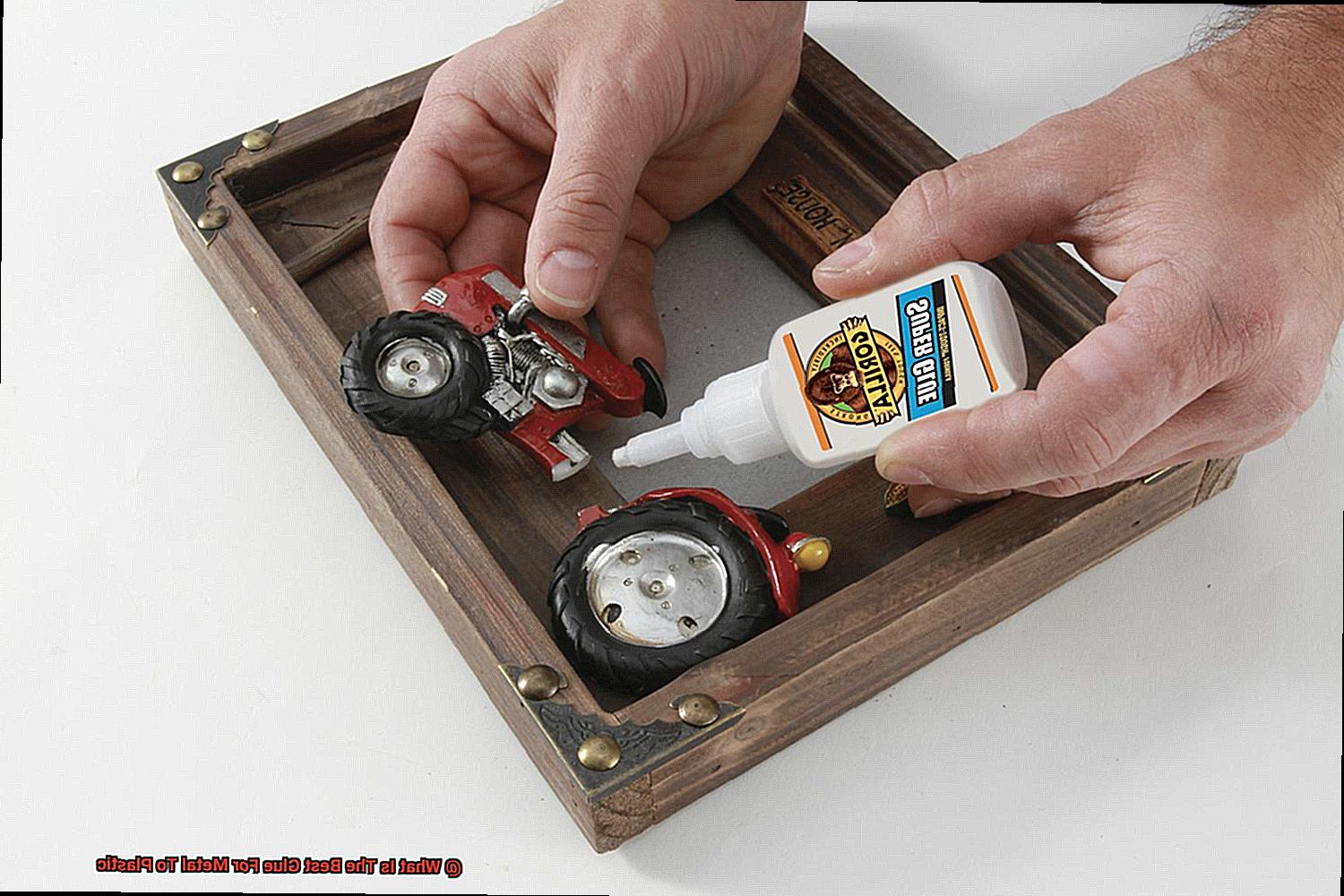
Resistance to Environmental Challenges:
From scorching summers to freezing winters, epoxy adhesives can handle it all. They boast excellent resistance to temperature extremes, chemicals, and moisture. So, whether your creation is exposed to the elements or submerged underwater, epoxy adhesives remain steadfast, ensuring your bond remains unbreakable.
Gap-Filling Capabilities:
Perfection isn’t always attainable when it comes to surface alignment. Luckily, epoxy adhesives excel in gap-filling capabilities. Even if your metal and plastic surfaces aren’t perfectly flat or aligned, the adhesive fills in any gaps or irregularities, creating a robust bond in less than ideal conditions. It’s like having a superhero tailor who can make any outfit fit perfectly.
Cost-Effectiveness:
Apart from their remarkable qualities, epoxy adhesives are also cost-effective. Their strength and durability mean you don’t have to worry about frequent repairs or replacements. Plus, they require minimal maintenance, saving you time and money in the long run.
Cyanoacrylate Adhesives for Metal to Plastic Bonding
Today, we’re going to delve into the topic of using these incredible adhesives for metal to plastic bonding. If you’ve ever wondered how to effectively join these two materials, prepare to be amazed.
Cyanoacrylate adhesives, also known as super glues or instant adhesives, are the rockstars of the adhesive realm. Their superpower lies in their ability to cure in a flash and create bonds that can withstand extreme pressure. These adhesives are built to last.
So, how do they work their magic? It all comes down to chemistry. Cyanoacrylate adhesives create a chemical reaction with the moisture in the air, forming an incredibly strong bond between metal and plastic surfaces. This makes them perfect for those tricky metal to plastic bonding situations where other adhesives might struggle.
To achieve the best results when using cyanoacrylate adhesives for metal to plastic bonding, it’s essential to start with clean surfaces. No dirt, grease, or dust allowed. Grab some mild detergent and give those surfaces a thorough scrub. Rinse them off completely and make sure they are completely dry before applying the adhesive.
Now, here’s a pro tip for you – roughen up those surfaces. Use sandpaper or an abrasive material to create small grooves or scratches on both the metal and plastic surfaces. This provides the adhesive with more area to grip onto, resulting in an even stronger bond. It’s like giving your adhesive superhero some extra muscles.
Once your surfaces are prepped and ready, it’s time for the main event – applying the adhesive. Squeeze a small amount onto one surface (remember, a little goes a long way.) and firmly press the two surfaces together. Hold them in place until the adhesive cures completely. The curing time can vary depending on the specific cyanoacrylate adhesive you are using, so make sure to check the instructions for the exact timing.
Now, here’s an important point to keep in mind – not all plastics are created equal. Some types, like polyethylene and polypropylene, have low surface energy and can be challenging to bond. In these cases, it’s best to seek out specialized adhesives that are specifically designed for bonding these types of plastics. They have the secret formula.
Specialized Adhesives for Specific Applications
Don’t settle for subpar adhesives when it comes to bonding metal to plastic. In this article, we will dive into the world of specialized adhesives designed specifically for this purpose. Whether you’re a DIY enthusiast or a professional in need of a reliable bonding solution, we’ve got you covered.
Epoxy Adhesives: The Superheroes
Epoxy adhesives are the superheroes of the adhesive world when it comes to bonding metal to plastic. With exceptional strength and versatility, epoxy adhesives form a tough chemical bond between these two materials. By mixing the resin and hardener just before application, you activate the adhesive’s superpowers, resulting in a strong and durable bond.
Cyanoacrylate (Super Glue): The Speedy Solution
Need a fast-acting adhesive? Enter cyanoacrylate, commonly known as super glue. This adhesive is perfect for smooth surfaces and provides a quick and secure bond within minutes. However, keep in mind that super glue might not be as effective on certain types of plastics or metals with oily or dirty surfaces.
Polyurethane Adhesives: Flexibility at Its Best
If flexibility is your top priority, polyurethane adhesives are your best bet. Commonly used in automotive and aerospace industries, these adhesives offer excellent flexibility, allowing them to withstand vibrations and movements without compromising bond strength. Moreover, they can brave harsh environmental conditions, making them ideal for outdoor applications.
Specialized Adhesives: Tackling the Tough Ones
When dealing with specific types of plastics and metals, specialized adhesives come to the rescue. For low surface energy plastics like polypropylene (PP) or polyethylene (PE), traditional adhesives struggle to create strong bonds. However, fear not. There are specialized adhesives available that can effectively bond these challenging materials together.
Environmental Factors and Their Impact on Glue Performance
When it comes to bonding metal to plastic, choosing the right adhesive is only half the battle. Environmental factors play a significant role in determining the performance and longevity of the glue.
In this article, we will explore the various environmental factors that can impact glue performance in metal-to-plastic bonding, providing insights to help you make informed decisions for your bonding needs.
Temperature:
Extreme temperatures can wreak havoc on your glue’s performance. Freezing cold or scorching heat can cause the adhesive to become brittle or lose its adhesive properties entirely. To ensure a strong bond, irrespective of the weather, opt for a glue specifically formulated to withstand temperature fluctuations.
Humidity:
Humidity levels can significantly affect the drying time and strength of the bond. High humidity can extend curing time, while low humidity can lead to premature curing, resulting in a weaker bond. To maintain a reliable bond regardless of moisture levels, choose a glue designed to perform well in varying humidity conditions.
Chemical Exposure:
If your bonded assembly will be exposed to chemicals or solvents, consider the chemical resistance properties of the glue. Certain chemicals can degrade or compromise the adhesive over time, leading to failure. Selecting a glue with excellent chemical resistance ensures a durable bond even in harsh chemical environments.
UV Radiation:
Outdoor applications require adhesives that can withstand prolonged exposure to sunlight and UV radiation. Some glues may degrade or discolor when exposed to harsh sunlight, compromising their effectiveness in bonding metal to plastic. Look for UV-resistant adhesives that maintain their integrity even in the harshest sunlight.
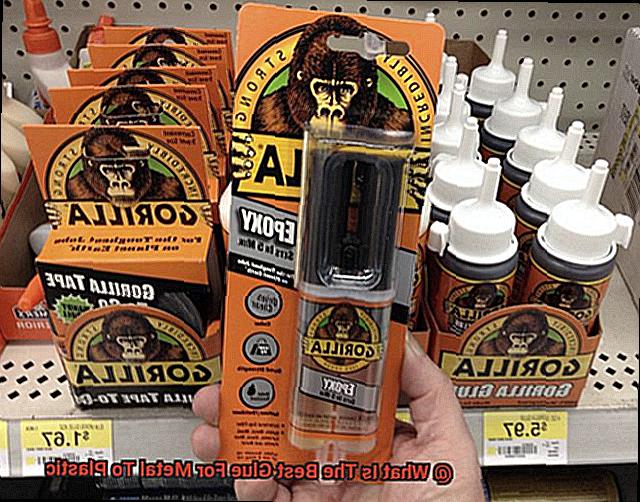
Mechanical Stresses:
Vibrations and mechanical stresses can pose challenges to bonded assemblies. Glue that lacks resistance to mechanical forces can weaken or fail under pressure. Choose an adhesive specifically formulated to withstand the specific stresses your application will encounter, ensuring a long-lasting and reliable bond.
Durability in Different Conditions:
For bonded assemblies facing challenging conditions like moisture, high temperatures, or other environmental factors, exceptional durability is crucial. Look for adhesives that have been tested and proven to maintain their bond strength over time, even in the most demanding conditions.
Strength and Flexibility Requirements in Metal to Plastic Bonding
In the world of metal to plastic bonding, strength and flexibility are the dynamic duo that can either make or break your bond. No one wants their meticulously crafted assembly to crumble under pressure, right? So, let’s delve into why these requirements are so vital and how the right adhesive can save the day.
Let’s start with strength. Metal and plastic surfaces face a barrage of forces, from tension to shear. To withstand these mighty pressures, you need an adhesive that can hold its own. Enter epoxy and polyurethane-based adhesives. These powerhouses possess Herculean strength properties, making them the ideal choice for applications that demand resilience. With these adhesives, you can forge an unyielding bond between metal and plastic, ensuring your assembly stands tall against the fiercest challenges.
Strength alone isn’t enough, though. Metal and plastic have different expansion rates when subjected to temperature changes. They’re like mismatched dance partners, moving at their own tempo. This creates stress on the bond interface, which can spell disaster for your adhesive if it lacks flexibility. But fear not. Flexible adhesives like cyanoacrylates or modified acrylics swoop in to save the day. These marvels can gracefully absorb the stresses caused by thermal expansion, keeping your bond intact even when things heat up or cool down.
Of course, strength and flexibility aren’t the only stars of the show. In this grand production called metal to plastic bonding, chemical resistance, impact resistance, and temperature resistance also take center stage. Different applications have different demands, so it’s crucial to select an adhesive that can handle whatever curveballs come its way.
sMrY7_V0I5A” >
Also Read: How to Glue Brass to PVC?
Conclusion
In conclusion, there is no shortage of exceptional glue options for bonding metal to plastic. Each adhesive type brings its own unique strengths and weaknesses, so it’s crucial to carefully evaluate your specific needs.
If you’re looking for a true superhero in the bonding world, epoxy adhesive takes the crown. With unparalleled strength and durability, it can bond different types of metals to plastics. Just keep in mind that it requires some curing time to reach its full potential.
For those seeking an instant fix, cyanoacrylate glue (aka super glue) is the go-to option. It offers quick bonding capabilities, but be cautious as it may not work effectively on certain plastics or metals with rough surfaces.
When extreme thermal stress conditions are at play, silicone adhesive emerges as the heat-resistant warrior. Able to withstand temperatures up to a scorching 600°F (315°C), it’s perfect for demanding applications.
If aesthetics are your top priority, look no further than acrylic adhesive. This clear-bonding wonder not only pleases the eye but also provides resistance against temperature variations and moisture.
In some cases, specialized adhesives may be necessary for specific metal and plastic combinations. These specially formulated glues offer optimal compatibility and superior bonding strength with certain materials.
To make the best choice for your metal-to-plastic bonding needs, consider factors such as material compatibility, required bond strength, application method, drying time, environmental conditions, safety considerations, and cost versus quality.
By selecting the right adhesive based on these key factors and your unique requirements, you can achieve a rock-solid bond between metal and plastic materials.

